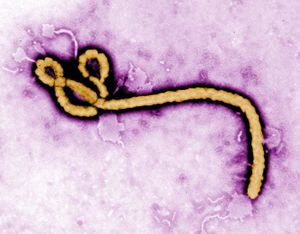Practice Template - Eva Illuzzi: Difference between revisions
(Created page with "==Introduction== Select a topic about genetics or evolution in a specific organism or ecosystem.<br> The topic must include one section about microbes (bacteria, viruses, fung...") |
|||
| Line 28: | Line 28: | ||
<br> <br> | <br> <br> | ||
== | ==Pathogenesis and Epidemiology== | ||
<i>B. fragilis</i> is often considered the single most important pathogen among the anaerobes that exist in the normal flora. Infections from <i>B. fragilis</i> commonly arise from a break in the mucosal membrane of the intestine.3 The travel of <i>B. fragilis</i> outside of the gut can lead to a variety of infections such as local abscesses at the site of the break, metastatic abscesses by spread through the bloodstream to distant organs, or lung abscesses by inhalation of the bacteria. | |||
< | |||
< | Predisposition to <i>B. fragilis</i> can arise from surgery, disease, or trauma. | ||
<i>E. coli</i>, a facultative anaerobe, uses the oxygen at the site which brings the oxygen to a level where anaerobes, such as <i>B. fragilis</i>, can thrive and grow. Due to this phenomenon, many severe anaerobic infections contain a mix of anaerobic and aerobic flora. | |||
==Section 2 Microbiome== | ==Section 2 Microbiome== | ||
Revision as of 21:52, 9 December 2020
Introduction
Select a topic about genetics or evolution in a specific organism or ecosystem.
The topic must include one section about microbes (bacteria, viruses, fungi, or protists). This is easy because all organisms and ecosystems have microbes.
Compose a title for your page.
Type your exact title in the Search window, then press Go. The MicrobeWiki will invite you to create a new page with this title.
Open the BIOL 116 Class 2020 template page in "edit."
Copy ALL the text from the edit window.
Then go to YOUR OWN page; edit tab. PASTE into your own page, and edit.

At right is a sample image insertion. It works for any image uploaded anywhere to MicrobeWiki. The insertion code consists of:
Double brackets: [[
Filename: PHIL_1181_lores.jpg
Thumbnail status: |thumb|
Pixel size: |300px|
Placement on page: |right|
Legend/credit: Electron micrograph of the Ebola Zaire virus. This was the first photo ever taken of the virus, on 10/13/1976. By Dr. F.A. Murphy, now at U.C. Davis, then at the CDC.
Closed double brackets: ]]
Other examples:
Bold
Italic
Subscript: H2O
Superscript: Fe3+
Pathogenesis and Epidemiology
B. fragilis is often considered the single most important pathogen among the anaerobes that exist in the normal flora. Infections from B. fragilis commonly arise from a break in the mucosal membrane of the intestine.3 The travel of B. fragilis outside of the gut can lead to a variety of infections such as local abscesses at the site of the break, metastatic abscesses by spread through the bloodstream to distant organs, or lung abscesses by inhalation of the bacteria.
Predisposition to B. fragilis can arise from surgery, disease, or trauma.
E. coli, a facultative anaerobe, uses the oxygen at the site which brings the oxygen to a level where anaerobes, such as B. fragilis, can thrive and grow. Due to this phenomenon, many severe anaerobic infections contain a mix of anaerobic and aerobic flora.
Section 2 Microbiome
Include some current research, with a second image.
Conclusion
Overall text length should be at least 1,000 words (before counting references), with at least 2 images. Include at least 5 references under Reference section.
References
Edited by [Author Name], student of Joan Slonczewski for BIOL 116 Information in Living Systems, 2020, Kenyon College.
